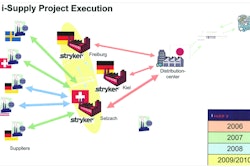
At last, warehouse management system solutions in the cloud are starting to emerge, long after areas such as transportation management systems (TMS) and supply chain visibility. As interest in cloud-based WMS is starting to grow, especially (but far from exclusively) for smaller and medium-sized facilities, it is important for companies interested in the cloud-based approach to understand: how vendor offerings for cloud WMS may differ, and how the kinds of capabilities and technology choices cloud WMS vendors themselves make can impact both the short- and long-term success of the WMS project.
Cloud-based WMS refers to an application that is delivered over the Internet, using backend servers (from the vendor directly or through a hosting partner) that are shared among a number of companies using the application. Putting these servers in the cloud and sharing their capacity enables cost synergies for the WMS vendor that can be passed on in the form of lower subscription prices, and also allows processing power to easily and economically harness from the full computing infrastructure as needed should facilities using the WMS need it for a period of time.
The attraction of cloud-based WMS is similar to that for on-demand software in any other area of the supply chain, but with some differences. The benefits common to all cloud-based software can include no up-front hardware and software investment, a pay-as-you-go type financial model, faster deployments and others.
But with cloud WMS, there is an additional benefit. Many companies have a variety of distribution centers or warehouses within their own networks, and sometimes in their extended networks. For some portion of these facilities, companies may believe that the scale of the operations and the functionality requirements do not justify the deployment of a full-blown WMS. Yet, some subset of those full capabilities would drive enhanced efficiency and control.
Cloud-based WMS can fit the bill nicely for these scenarios, but what is not well-recognized is just how good that fit will be is largely dependent on how the cloud-based WMS was developed.
For example, in smaller facilities with reduced functional needs, companies may not have a lot of resources to set up even these simpler WMS systems and get them up and running—or at minimum, would welcome those setup requirements to be reduced even if they have resources.
That means the traditional approach to WMS including configuration, training, go live, etc. must be significantly changed for on-demand scenarios. The cloud-based WMS must be delivered with a new set of tools, which are simple, intuitive and designed for total self-service, for configuring the system and making the required functionality available for use.
This approach to setup is simply not how a traditional WMS is built, and frankly, most native on-demand solutions were not developed with this system-driven configuration approach in mind either. It takes a lot of extra work and development to build this kind of self-service configuration front-end, which can ensure that users on their own at a remote site will get the setup right and start using the software quickly and effectively.
Delivering What Users Need—and No More
Second, it is critical that the cloud-based WMS not only delivers the right functionality, but also the right functionality. Even in smaller facilities, initially and especially over time, companies will find they have additional needs as the market and their businesses change. That is even truer for mid-sized and even large facilities that may also be interested in cloud WMS deployment.
To date, there are two primary approaches to on-demand WMS: Lower end systems built especially for on-demand/cloud applications and more sophisticated, advanced WMS systems built for traditional on-site deployment that are simply ported to a web/hosted framework.
There are potential problems with both of these approaches. In the first case, the cloud-specific WMS will usually lack advanced features that are required for more complex facilities. In addition, sometimes even a small or low-complexity distribution center can require a capability or two that would normally be considered advanced and not available in basic on-demand systems.
In the second case, putting the full capabilities of an advanced WMS on the web adds needless complexity and overhead for the application environment. While it is true that features and capabilities not required can be hidden from the user, there may still be a lot of setup complexity due to the full system really being available. That full system also carries with it some processing overhead that may somewhat reduce WMS responsiveness. That is not what you want in a cloud-based application in which the software could be subject to some vagaries of performance when being accessed over the public internet.
A much better approach is this: Provide a basic set of capabilities for a cloud-based WMS that will meet the needs of many companies and facilities, but as new requirements emerge, or the WMS is deployed at larger or more complex facilities, the company is able to access just the additional functionality they need. Just that and no more.
Let's use the analogy of a 100-story building that represents the full advanced WMS capabilities. The cloud WMS may provide the bottom 10 stories of that building and serve as the foundation of what most cloud-based users need, and which is designed from the beginning to support the full WMS building structure. But users get just those first 10 stories to start because that is what they need, not all 100 floors, as would be the case in Scenario 2 above.
But, if initially or down the road additional functionality is required, such as represented by stories 17, 21 and 76 of the full building, the company should be able to access those additional capabilities as well—and only those capabilities. This keeps setup, maintenance and usage simple, while optimizing system performance.
As should now be clear, when starting to look for cloud-based WMS solutions, there is much more to consider than just what functionality seems to be there. The existing high- and low-end approaches can create issues for companies both in getting the system up easily and effectively at the start, and how well the system can empower changes over time.
There are a number of other considerations potential buyers should consider as well, such as whether data communications between the user interface and/or radio frequency (RF) devices and the backend servers were optimized for performance over the web, and how security is being managed, that will differ (sometimes greatly) between vendors.
The bottom line: Building a WMS specifically for the unique characteristics of cloud-based deployment, and how the software is likely to be used over time, can provide simplicity at the start and much flexibility over time, leading to maximum system success over its lifetime.
Dinesh Dongre is the vice president of strategy at Softeon, a provider of supply chain software, including cloud-based WMS.














![Pros To Know 2026 [color]](https://img.sdcexec.com/mindful/acbm/workspaces/default/uploads/2025/08/prostoknow-2026-color.mduFvhpgMk.png?ar=16%3A9&auto=format%2Ccompress&bg=fff&fill-color=fff&fit=fill&h=135&q=70&w=240)

